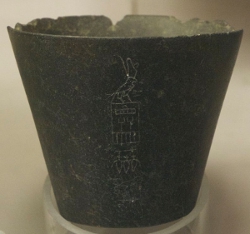
Hotepsekhemwy (“The two powers are satisfied”) is a shadowy figure who ruled ancient Egypt during the second dynasty during the Old Kingdom. His Nebty name, Hotepsekhemwy, means “the Two Mistresses are appeased” (referring to the goddesses of Upper and Lower Egypt). This suggests that either the pharaoh had reunified upper and lower Egypt after a period of disharmony, or he wished to. There is some evidence of dynastic strife later in the dynasty, but little is known about Hotepsekhemwy’s reign despite its apparent length. Manetho credits him with a 38 year reign, but many modern scholars suggest he only reigned for between 15 and 25 years.

There is some evidence that he introduced some minor reforms to both religion and the administration of Egypt, but his rule is only confirmed by the inscription on the back of a statue of a priest who lived at the time and from a small assortment of items including a few seals bearing his name discovered in a couple of dynasty two tombs at Saqqara and the tomb of his predecessor Qa’a in Abydos. This does not add much support to notions of dynastic struggle as it implies that even if Hotepsekhemwy was not actually a son of Qa’a, he certainly buried him with all honours. If this is the case, why did Manetho ascribe him to dynasty two. It may have been as simple as a shift in the location of the capital to Memphis, but unfortunately Manetho does not give his reasons.
One reason could be the existence of at least two kings between Qa’a and Hotepsekhemy. Rulers named Sneferka (who may have been a queen not a king) and Bird are referred to on inscriptions found in Djoser’s Step Pyramid Complex, and it is suggested that these lower Egyptian kings held the throne for a short period. This may explain why he was apparently the rightful successor of Qa’a, and yet he was the founder of a new dynasty. It would also explain the reasoning behind his Horus name. He is generally ascribed the Nebty names “Sen-nebty” and “Hotep-nebty”, but some suggest that these names referred to other princes, not the pharaoh.
A granite statuette of the mortuary priest named Hetepdief, lists the names of Hotepsekhemwy, Raneb and Nynetjer, suggesting that there was no successional problem at the beginning of the second dynasty.
Manetho states that during the 38 year reign of Boethos (or Bochos) a “chasm” opened at Bubastis and many people died. There is evidence that there was an earthquake during Hotepsekhemwy’s reign and so it is suggested that Boethos and Bochos (from Africanus and Eusibus respectively) are simply Greek misinterpretations of the names Bedjaw (his nomen as given on the Abydos list) and Baw-netjer (“the powers of the gods” – his nomen on the Turin and Saqqara lists).
Even stranger, it seems that these names themselves could be a misinterpretation as they do not appear in any contemporary inscriptions. “Bird” (who may have been pharaoh briefly) wrote his name using the glyph of a bird, which could have been misinterpreted as a Ba bird. As “Bird” left little evidence of a rule he could easily have become muddled with his successor.
Pharaoh’s Names
Manetho; Boethos

Hotepsekhemwy’s Nebty; ‘Hotep’

Nomen; Baunetjer (from the Turin list)

Nomen; Baunetjer (from the Saqqara Kings List)

Nomen; Bedjau (from the Abydos kings list)

Nomen; Bedjatau
Copyright J Hill 2010